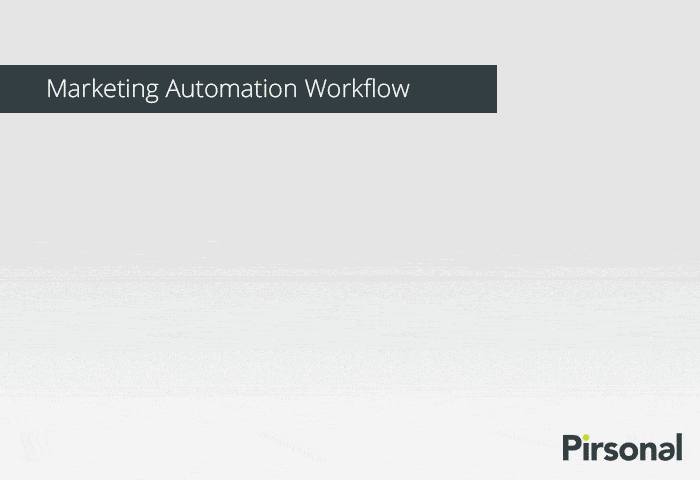Creating personalized video messages can be more complicated than it seems at a glance.
Personalized video messages are generally used in creative advertising, marketing automation strategies, customer experience initiatives, and account-based marketing. One of the main reasons why organizations make personalized video messages capture their audience’s attention with a unique narrative.
Video personalization helps brands to create highly targeted video content for segmented audiences.
By using video marketing automation, organizations increase the level of customer engagement because they deliver an immersive experience that makes their unique audience react.
A video that has been customized to a customer like if it was hand-made simply converts better.
The only downside to generic messages that I can think of is that personalized messages in video require a different mindset.
But this is one of the reasons why you are reading this article.
Over the last few years, I have worked with well-known brands, as well as organizations that I have never heard of.
I have had the privilege of working on projects with personalized videos with decent budgets.
These projects are usually managed by our video production service for personalized video marketing.
Also on projects that are a better fit for our self-service platform to make personalized videos at scale. Since organizations can start with a personalized video free trial, it is a no-brainer.
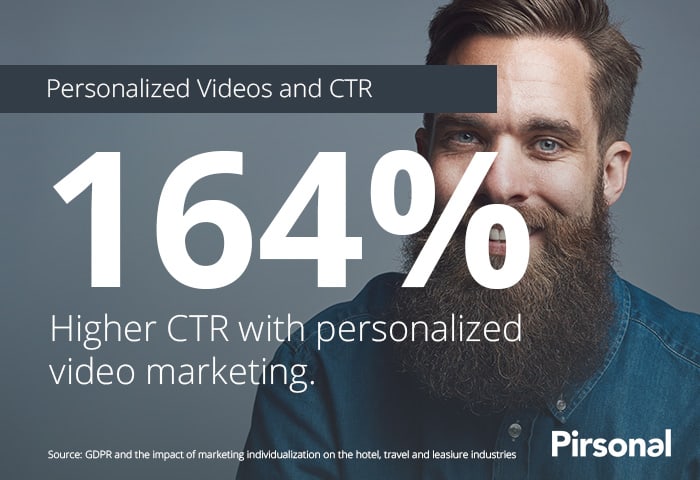
From all of this, I’ve learned a lot about how to create personalized video messages that convert, grab your audience’s attention, and go one step further.
No matter your budget.
In this article, you will discover techniques to help you be creative in advertising and email marketing campaigns with personalized video messages.
First, make sure to watch the following video. It explains the key concepts about creating personalized messages for marketing and the importance of a granular approach.
What is a personalized video message?
A personalized video message is a video that is automatically created using structured data, such as dynamic texts, images, videos, and audio.
Video messages that are personalized allow you to make every video relevant to each individual at scale. This means that the video message is personalized for your target audience, one at a time, automatically.
Most of the time, organizations simply feature a customer’s name on the personalized video.

If you are already doing this, this is great. You are already doing more than the majority of marketers.
However, you will be with me that you can most likely do better.
Regardless, keep reading. You’ll take your video marketing strategy one step further.
Personalized video messages are effective.
They attract your customer’s attention.
They are easy to remember.
If we talk about conversions, you probably already know that video is king.
Well, a personalized video message is about 164% more effective than a generic video in terms of CTR.
Why Creating Personalized Video Messages At Scale
Personalized video is video content that is designed to share personal communications with your audience. But why taking the time to create personalized videos at scale for your marketing? Personalized video messages perform better than generic videos. In terms of sales, personalized videos are 116% more effective than videos are not personalized.
To put this into perspective, remember that video is the type of marketing content that performs the best.
For example, this financial services firm added personalized video messages to the customer journey and increased after-sales customer engagement by 25%. As you’ll see, they used email marketing automation and SMS marketing as well, which means that they also personalized the distribution channel according to the customer’s preferences.
This is aligned with the fact that marketing personalization is the new it-is-here-to-stay norm. For example, in-house marketers who are personalizing their web experiences see on average a 19% uplift in sales, email marketing regularly sees a whopping 440% ROI when implemented effectively, or 44 dollars for every dollar spent.
Personalized video marketing greatly benefits from marketing automation strategies. 75% of email revenue is generated from Personalized Campaigns powered by marketing automation.
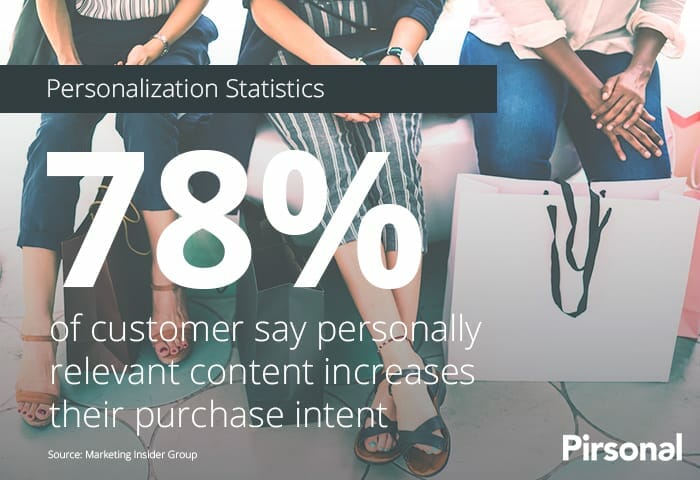
Video Personalization Opportunities For CX
Video personalization is used in various ways by organizations across different industries to improve customer experience and ultimately get more sales.
Here you have the most common ways organizations from Travel to Financial Services are using personalization with video, even for gamification goals:
- Thanking donors
- Onboarding new customers
- Increasing the revenue per customer with upsells
- Data-driven internal communications
- Keeping existing customers informed
- Activating users around a causey
- Sharing socially
Check this complete guide with explained personalized video examples and strategies you can use today.
Strategies To Create The Best Personalized Video Messages To Increase Customer Experience
Know Your Goals and Desired Outcomes
You are about to add video personalization to your marketing arsenal.
At this stage, you know that there are different ways you could add your customer’s name and logo to the videos.
You have probably already seen examples of personalized videos.
Although you have a thousand questions, you already know that when you create messages with personalized videos, you can also personalize images, videos, and audios.
Yes, audio too. For example, using custom voice-over, or even automated voices (TTS).
You have even made some research to find creative clean background videos where you can add the dynamic placeholders.
But there is a problem.
Based on my experience, chances are that you are still in the “this is really cool” stage.
And it is a dark area. Let me explain why.
If we get serious, we all know that any marketing initiative must render certain KPIs.
This is why defining your business goals is the most important part of your personalized marketing plan with video
This will help you be more specific from every angle.
From which personalized video vendor to choose, to how simple or complex your video templates need to be.
Even you the type of marketing automation workflow or if you’ll make the personalized videos using a spreadsheet.
Personalized video marketing is not magic. It requires a strategy.
In the following video, you’ll find a few ideas that will help you set your video personalization goals.
Being as specific as you can about your personalized video marketing business goals will help you increase your success rate.
How to define your personalized video message goals
The following questions will help you create the general framework for your video personalization goals:
- What are your current conversions and KPIs from campaigns launched toward similar audiences? And your expected KPIs and conversions?
- How and who are the buyer personas for the personalization creative campaign or automation workflow?
- What kind of customer data you have access to?
- Are there any legal requirements to take into consideration? (For example, GDPR forces modern marketing to be more conversational)
- Can you create augmented buyer personas to increase engagement? (This is buyer persona + real customer or lead data to create contextualized marketing messages)
- What is your budget? Is this an initiative that multiple departments will benefit from?
- Who is going to execute the project? Will you rely on a video marketing agency or will you execute the project internally (it is usually executed by video designers, customer experience managers, marketers, or developers)?
- What is the most effective communication channel to send personalized videos through (email, SMS, WhatsApp, landing page, etc.)?
- What other personalized media assets will you need? From dynamic landing pages to personalized video calls-to-action.
Use Marketing Segmentation To Create A Personalization Strategy
Market segmentation is the process of dividing up mass markets into groups with similar needs and wants. Market segmentation has become the essential rule of any marketing strategy, not only in the digital field.
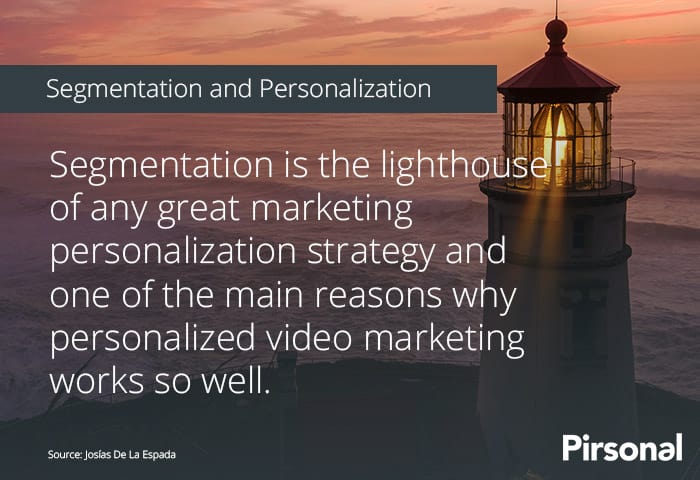
Segmenting a market according to certain characteristics will allow your organization to be much more effective when choosing which product to create, what improvements to make, and which audience you will target.
It will also allow you to assign the appropriate budget to any marketing initiative. The reason for this is that you will be able to know in advance the average size of the audience you will be targeting with segmented messages.
These messages can be personalized or not. There are times when you can’t personalize your marketing messages because you don’t have enough information. In these scenarios, you’ll focus on creating segmented marketing messages, even with video, according to customer segments.
When you have customer data in a CRM, email marketing tool, or marketing automation software, marketing segmentation is even more fun because it takes to a new arena.
Sweet personalization.
Proper segmentation allows you to see in a granular way what your customers, users, or leads are like. It allows you to identify patterns of behavior as well as patterns of information.
At the same time, customer segmentation allows you to enter into the wonderful and profitable field of personalizing your marketing. And from here, you take the leap to create messages with unique personalized videos at scale.
Take a look at the following personalized video message example. In this case, it is not powered by real people or stock video. Rather, this brand decided to use animation.
In marketing, microsegment or micro-segmentation is a more advanced form of market segmentation that groups a number of customers of the business into specific segments based on various factors including behavioral predictions.
Through micro-segmentation, brands can get granular when interacting with individuals within specific audiences. In the current climate, it’s more important than ever to create a marketing that talks to the individual, rather than to the audience.
Types of Segmentation
There are different angles you can implement for your marketing and customer segmentation.
Remember that market segmentation helps you better target your marketing efforts by sending the right messages to the right consumers.
Segmenting your marketing audience has several advantages:
- From a creative perspective, you can use them to craft the right message using buyer personas. I’ll talk more about buyer personas for your personalized videos below.
- From a distribution perspective, segmenting helps you know if a personalized video should be only for the viewer’s eyes, or if the video can be shared publicly, for example through social media platforms like Facebook or Twitter.
Improve Your Video Marketing Strategy With Segmentation
A key aspect of creating personalized video messages is deciding the segmentation angle you’ll use. These are the three main market segmentation angles:
Homogeneous
It groups your clients based on their common needs and creates a set of personalized videos that address those needs. The personalization video messages resonate with each member of that common group.
The following automated video message within the fitness industry uses a homogeneous marketing segmentation strategy. This is, you club together with your clients based on their common needs and create a set of personalized videos that address those needs.
Distinctive
With this distinctive aspect of market segmentation, each client within the common needs group is also a unique entity.
For example, the differentiators could be anything from your customer’s age, designation and department or tenure to the car they drive, the baseball team they root for, their persona, and their interests.
If you are into B2B marketing (for example, account-based marketing and sales), you can intelligently tap into such data to automatically create personalized videos that account for the individual differences among your clients.
Here is an example of a personalized video that uses distinctive customer segmentation. As you’ll see, each client within the common needs group is also a unique entity. A personalized video message is created using customer data such as customer name, destination when doing travel and hospitality marketing, dates, sales executive’s contact details, and more.
Reaction
The reaction aspect of market segmentation pertains to how your clients react to the customized videos.
This means that some reactions will be predictable and common across the entire group. At the same time, other reactions might differ from client to client.
Your marketing segmentation strategy uses this to design the interactive elements. For example, this is key to create video calls-to-action that is personalized to each customer.
This helps you to optimize reactions and perhaps even turn them into potential leads for the sales team. Take a look at the Pirsonal Player to learn more about this.
The following image shows an example of a personalized video call-to-action using Pirsonal’s interactive video player.
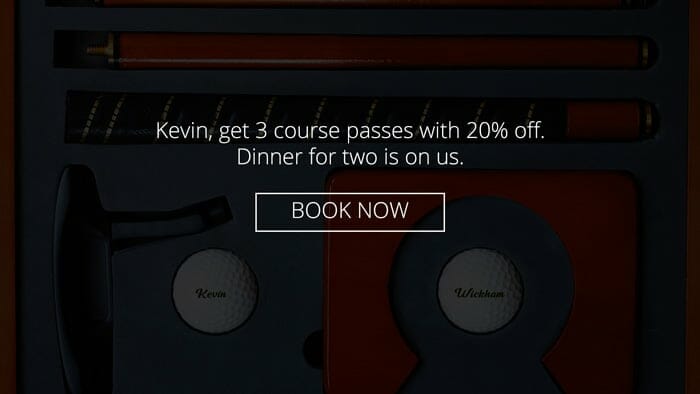
Easy Segmentation Criteria For Video Marketing
When creating personal videos for your marketing, you can go one step further and use the following seven easy ways to segment your marketing audience.
- Demographics: It analyzes who your customers are based on criteria such as age, income, number of family members, race, gender, occupation, education, and nationality.
- Skills and knowledge: It studies the things your customers know and how they apply this knowledge when they interact with your organization.
- Preferences: It divides your customer groups taking into account the things your customers like about your brand, products, services, and team.
- Behavioral activities: It analyzes the behaviors and decision-making processes your customers follow.
- Psychographics: It takes into account how your customers think. With this, it divides the markets according to lifestyle, personality traits, values, opinions, and interests of consumers.
- Behavioral use: It covers how your customers use your products and services.
- Buying behavior: If focuses on how your customers buy: their budget, timing, device, triggers.
Use this as well to analyze your prospecting spreadsheet, CRM customer lists, or any other tool where you manage your customer data.
In the following video, I talk more about these seven ways to segment your marketing to create personalized messages for your videos, emails, and other multimedia assets:
Create Buyer Personas To Increase Personalized Video Messages Watch Time
In the process of conceptualizing how your personalized video campaign will look like, you need to go back to your buyer personas. This will ensure that viewers will spend more time watching the videos.
Personalized marketing should always be based on real users, leads, and customers.
This will help you achieve a higher grade of effectiveness.
If not, you are, basically, throwing your marketing budget into the trash.
What is a Buyer Persona?
A buyer persona is a fictional character created to represent a user type that might use your product or service.
It is also is the person that will consume your marketing messages.
Sometimes marketers put a lot of effort into thinking about robust buyer personas.
This is great. The problem is when marketers don’t invest the same time into thinking how to use this knowledge to create personalized marketing messages.
How to use buyer personas to create personalized video messages?
Buyer personas are fundamental to create customized marketing messages.
The first step to customizing video messages at scale powered by buyer personas is to study your customer database and the leads captured by marketing.
To do this, check your customer relationship management software (CRM), email marketing tool, customer experience software, or marketing automation tool.
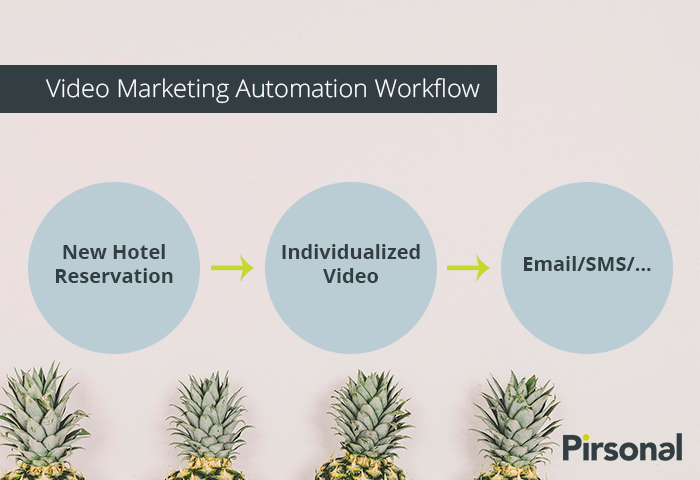
Here, you want to find patterns that are representative of your customers or leads.
Create a specific segment that you’ll target with the personalized marketing campaign.
If you haven’t created buyer personas yet, extract patterns that could help you create them. Talking to your sales and customer success teams will be really helpful.
When you know your target audience more accurately, you can create video scripts that cater to who they are.
This way, you can also use personalization in different lines in the script and on the timeline to hook unique viewers and make them spend more time watching the videos
It’s a natural way to push them to the next scene until they get to see the custom call to action.
We see that using personalization creatively can help you improve your watch time considerably. This brings us to the next point that I would like to talk to you about.
From buyer persona to augmented buyer persona
There are times when creating a buyer persona for your video marketing strategy is not enough.

If you already had buyer personas and your customer data goes beyond “name”, you can uplift your video marketing strategy with augmented buyer personas.
An augmented buyer persona is the profile of an individual comprised of all the interrelated information gathered about that individual provided by one or many data sources and the individual’s buyer persona, taking into consideration the individual’s particular context to create products, services, and, most commonly, marketing messages that fit the individual’s needs, objections, desires, and interests, aligned with the objectives set by the organization.
I recommend using buyer personas to design personalized marketing assets.
However, you want to use the augmented buyer persona to create a personalized video message that is unique to the individual.
How to use customer or lead data to create customized videos that capture your audience’s attention
To creating video messages that are specific to each customer, you need to use any kind of customer data.
Select the information you can use to create powerful personalized and hyper-personalized video messages based on your data source.
These messages must be fully contextualized to each recipient. For example “First name”, “City”, “Interests”.
First, take a closer look at the customers’ segment.
Try to find similarities in the data. If you can structure these similarities in a spreadsheet, then you can use this customer data to create personalized video messages.
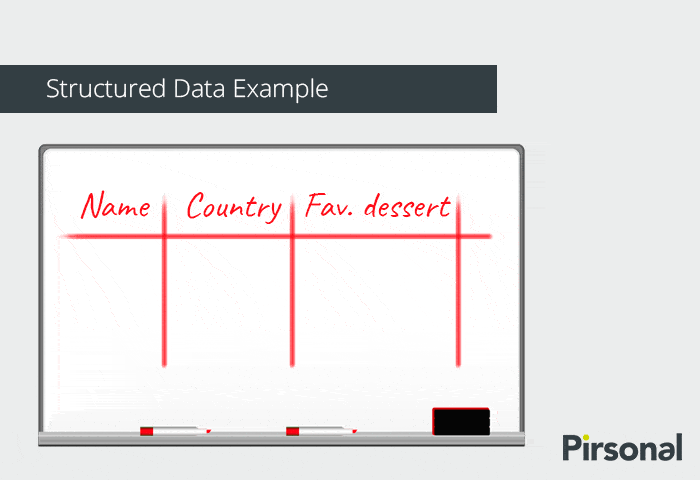
A spreadsheet is the easiest example of structured data
Note that it doesn’t mean that you need to use a spreadsheet.
You need to be able to structure the information so that you can then use it according to the type of content you want to customize.
Marketing personalization is about leveraging your customer data to connect with people through custom messages.
My recommendation is that you “translate” your customer data into something that is appealing for your customer, aligned with your business goal.
Take a look at the following personalized email example. It showcases a personalized video message sent by email.
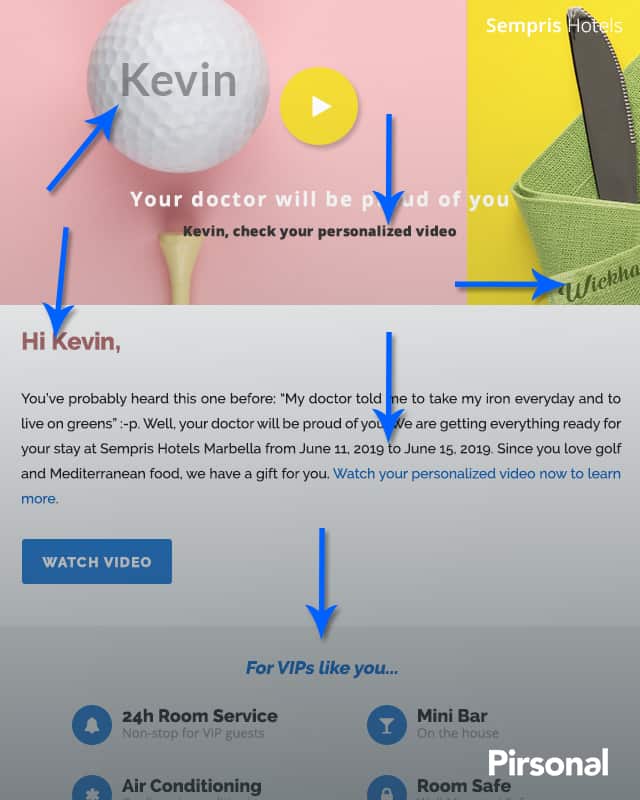
Now check this video where I explain how I created this personalized marketing example.
Sending A Personalized Video Message To Your Customers: From Email to WhatsApp Marketing
Based on your conversion goals, segmented audience, and type of message, understanding how to send your personalized video messages by email or any other type of direct messaging is really important.
Video messages are not the only thing you can personalize.
You can increase video engagement and CTR dramatically by personalizing the communication channel.
Nearly nine out of every ten marketers use email marketing to distribute content organically.
Does this mean that you always need to use email to send personalized videos to your customers or leads?
If we are talking about account-based marketing (ABM), maybe.
This example shows an animated gif automatically extracted from a personalized video. The goal? Increasing email CTR.
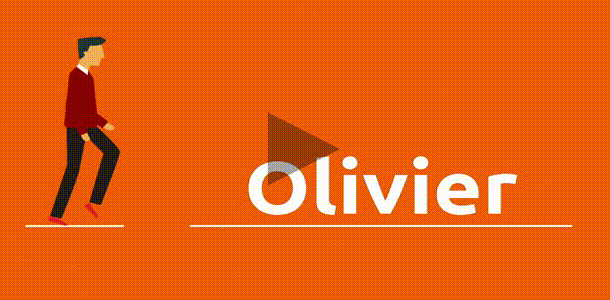
B2B marketing relies heavily on email marketing.
Email is easy to track, cheap, and scalable. There are countless email marketing automation tools you can use, regardless of your budget and audience size.
But, what about B2C marketing? Is email still the most effective channel?
Maybe.
Double-check your past campaign performances on an individual basis to know what has worked better.
If your customers, users, or leads base have already chosen which marketing channel they want you to use, there is not that much you can do.
Focus on improving opening rates and CTR performance.
If you can choose for them, again, focus on what has worked better in the past.
For example, maybe B2B customers from Latam or Asian markets prefer WhatsApp to do business, even using their personal lines. While decision-makers from the UK or Germany will never use WhatsApp or any personal communication channel to do business.
Adapt Your Video Marketing Strategy To Each Communication Channel
When working with video marketing strategies, you always need to take into consideration your target audience’s attention span.
Marketing with personalized videos is no stranger to this.
The communication channel plays a major role and will have a deep impact on the type of content that is shown in the personalized video message.
For example, if the personalized video message is shared by SMS, chances are that the video will be shorter than other versions optimized for desktop.
Personalized video messages optimized for mobile viewing should have larger text sizes, bigger images, and allow the user to consume less information in less time.
At the same time, if you are sending customized video messages by SMS or WhatsApp to business people, using personalized audio may have less impact than if the content is displayed on a computer.
Just imagine you are doing ABM and decided to send a personalized video by SMS to one of your hot leads…
This lead receives the message while he is in a meeting, opens the link, and finds a wonderful video whose main content is intended to be heard, instead of seen.
That’s bad news. The lead will need to wait until he finishes the meeting to watch the personalized marketing message.
At the time that happens, chances are that another email, SMS, or call will get his attention.
There you lost it.
These little details can make a huge difference in your conversions.
Use Existing Integrations to Launch Your Personalized Marketing Campaign In No-time
If it is the first time you are working with personalized video marketing, chances are that you are thinking big.
If this is a one-time campaign, you can use spreadsheets to make personalized videos online.
In the following video, I explain the full process using Pirsonal’s Campaign tool.
But there are times when you want to have a marketing automation process in place.
This is when the automated video content is created based on a trigger.
For example, if you do ABM and use a tool like Hubspot CRM or Marketing, you can automatically create a personalized video message for each lead that is added to one specific list.
Or if you use a marketing automation software like Activecampaign, you can easily create personalized marketing workflows that at any stage of automation trigger a personalized video.
Choose the necessary technical integrations to connect the data source, the personalized video platform, and the distribution channel.
Thanks to Pirsonal’s Zapier integration, you can easily connect our personalized video marketing software to more than 2,000 integrations. From Salesforce to Google Sheets or Mailchimp, you can add personalized video messages to any direct communication channel, like email.
When is it a good idea to use a personalized video API instead of a CSV or existing integrations?
Using a personalized video API is a good option when you are under most of the following scenarios:
- You need to make more than 50,000 personalized videos.
- Your structured customer data comes from an existing API, database, or service that is not supported by services like Zapier or Integromat.
- You need a complex video generation system that is unique to your needs.
- The personalized video messages need to be created based on sporadic triggers.
- The video marketing initiative with video personalization will last at least 6 months.
- You have the time, resources, or budget to work on custom integration (BTW, we can always help)
